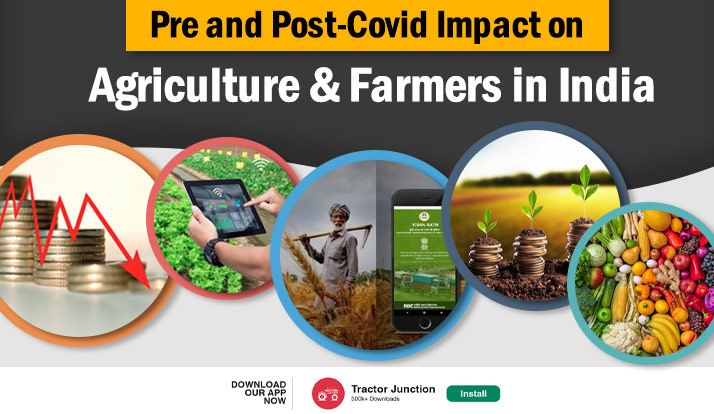
Covid-19 has been an unprecedented challenge for India. The vulnerability of the Indian agri-food system & supply chains and depleted workforce have badly hurt high-value farm enterprises, small and marginal farmers alike. Food availability in the less-privileged and rural areas of the country the lockdown became a problem for administrators and researchers people’s resilience reached a breaking point in the face of prolonged unemployment.
The ongoing crisis has accelerated the need for digital solutions, and the need to reform and decentralize agricultural food market systems. Governments at the Central and State levels have taken several measures to help the agricultural sector overcome this disaster. This post aims at highlighting the Pre-Covid and Post-Covid impact on Indian farmers based on five significant factors. Without any ado, let’s start.
See Also – Top 10 Agriculture Tools
Procurement and Prices
Pre-Covid Situation
Fruits, vegetables, and various other agricultural products were in high demand the Covid-19 hit. The absence of multiple market avenues and real-time price information, linkage with value chain actors such processors and exporters, stocking limits, and restrictions on the movement and sale of agricultural commodities resulted in a massive stockpile, crashing of prices, and increased farmer losses.
Post-Covid Situation
On the Central government’s recommendation, various state governments have temporarily suspended the Agriculture Produce Market Committee (APMC) Act and let farmers sell their produce anywhere. The removal of stocking limits and allowing agro-processing enterprises and large private buyers to buy directly from farmers has helped create competition and backward linkages with farms. A national-level project is in the pipeline to help create a dashboard or app to disseminate the daily prices of major agricultural commodities. Several states have started using SMS-based pre-registration systems to manage and regulate agricultural produce’s arrival and logistics.
See Also – Smart Farming Ideas
Digital Solutions for Better Supply Chains
Pre-Covid Situation
The inability to forecast problems, absence of mobile procurement of perishable commodities, e-commerce platforms, and limited access to funds, technology and market information left farmers facing considerable difficulties in harvesting and selling their crops.
Post-Covid Situation
Post Covid-19, new technologies are being developed to facilitate the management of supply-demand interfaces and supply chains. Initiatives such the procurement of agricultural commodities through the National Agricultural Cooperative Marketing Federation of India (NAFED), Farmer Producer Companies (FPCs), and corporations, creating farm-to-market linkages, providing farmers with easy access to credit and guidance on technology & digital solutions, and encouraging Agri-tech start-up firms have helped prevent farmer losses, and improve input and output supply chains.
See Also – Top 10 Mini Harvester
Labour Scarcity and Poor Livelihoods
Pre-Covid Situation
The scarcity of farm labor was a concern. The Covid-19 crisis only helped expose the already existing fragilities of rural and migrant workers’ livelihoods, food security, and well-being.
Post-Covid Situation
The Kisan Rath mobile app, launched by the Government of India, is proving very useful in connecting farmers and traders with transporters across the country. Around 2,00,000 farmers and traders have already registered to use the app. The new One Nation One Ration Card (ONORC) scheme has helped beneficiaries avail subsidized food anywhere in the country, irrespective of their residence.
Capital and Credit
Pre-Covid Situation
Scarcity of capital was a significant constraint in enhancing agricultural productivity and diversification. Small and medium enterprises’ rising unemployment and economic impracticability negatively impacted small, marginal and farmers with high net worth. Losses suffered to the disruption of harvesting, and markets led to rampant farmer suicides.
Post-Covid Situation
Central and State governments have introduced several initiatives to help SMEs survive, maintain value chains, and create markets for farmers. Ensuring SMEs’ access to smooth and reasonable credit lines from lending institutions enabled them to effectively manage the crisis and connect directly with the farmers. The provision to cover farming losses under the Pradhan Mantri Fasal Bima Yojna (PMFBY) has helped restore farmer confidence.
Decentralization and Diversification
Pre-Covid Situation
The supply of fruits, vegetables, and other agricultural products in India has been a constraint for some time now. Food and nutrition insecurity, the absence of regional and community-based buffer stocks, and the lack of structural reforms such land leasing, contract farming, and privatization of agricultural markets hampered farmers’ growth in India.
Post-Covid Situation
The government has used this opportunity to encourage urban households to grow food, wherever possible, to add to the dietary diversity. A paradigm shift has been made towards the development and diversification of local food systems, and the implementation of schemes such the National Nutrition Mission (NNM) and Public Distribution System (PDS) to create convergence and target local solutions for people residing in vulnerable regions that face greater poverty. The Government of India has introduced several ordinances allowing barrier-free trade, unrestricted movement of farm products across states, and removing cereals, pulses, onions, potatoes, oilseeds, and edible oils from the purview of the Essential Commodities Act.

Conclusion
The hardships caused by Covid-19, the crisis has revealed the weaknesses in India’s Agri-food system. The knowledge has helped guide reforms to make food systems and livelihoods more flexible and resilient. The introduction of agricultural market reforms, digital solutions to connect farmers to markets, reasonable working conditions, decentralized food systems, and the creation of safety nets have helped improve the condition of farmers in India post-Covid-19.
See Also – Coronavirus National Helpline Number
